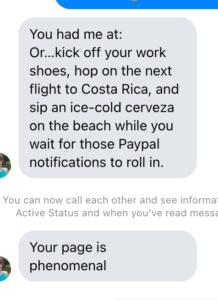Two years ago, I waved “adios” to my remote job as a content marketer — and became a full-time freelance copywriter.
I was making $23/hour in my remote job and while I loved the location independence that it afforded me, I wanted *more* freedom. Freedom to charge my own rates (ahem more than $23/hour). Choose my own hours. And work whenever I felt like it.
It took some time to get my feet off the ground. But two years into my business, and things are going preeeeetty well.
Two months ago, I made $11,988 in a single month. Working only around 20 hours per week.
Last month, I pulled in just under $9k – and that included a one-week vacation in Italy.
And this month, I’m on track to make at least $10k — while taking a one-week “vacation” (slash having a seriously unproductive week) and an escapade to Berlin.
See, that’s the beauty of freelance copywriting. You get to:
- Roll outta bed without an alarm – and work during the hours that YOU want
- Take time off whenever you feel like it
- Charge the rates that you want
- Scale quickly
- Work from anywhere in the world (as long as you have a wifi connection)
Sound too good to be true? It’s not.
Truth is…
ANYONE can become a (well-paid) freelance copywriter. You don’t need any prior job experience. You don’t need a college degree. And you definitely don’t need to put together some fancy resume.
But you DO have to be willing to learn. Get good. And be willing to put yourself out there.
Up for the challenge? If so, then you’re in the right place. I’m going to tell you how I became a freelance copywriter with no experience or portfolio. And how you can too.
But first…
What is copywriting anyway?
To put it in layman’s terms, copywriting is salesmanship in print. It’s the process of writing promotional text that persuades people to take action.
Many people confuse copywriting with content writing. But there’s a distinct difference. The goal of content writing is to inform and educate. It’s used for more top of the funnel marketing material like blogs, lead magnets and eBooks.
(Don’t know any of that terminology? We cover all of that — and much more – inside the Nomad Copywriter Starter Kit.)
The goal of copywriting is to sell. Or get people to take action. Good copy relies on persuasion techniques, data and science.
Because copywriting is more directly linked to sales, it pays more than content writing (A LOT more).
But to be a good copywriter (and charge premium rates), you can’t just be a good writer. You have to be a good marketer too. You gotta have a solid understanding of marketing principles and what makes people tick.
If you don’t know any of this – don’t sweat it! I’ll teach you how to get there.
A few things to know before getting started
1. This isn’t a get-rich-quick kinda thing
The first year or two of freelancing can be frustrating AF. You might feel like giving up at times (I know I did).
You might have a few projects – and then nothing for weeks. Or months. Maybe you’ll have a few hellish clients who don’t know their boundaries and make you question your sanity.
But if you stick it out and put in the work, things WILL get better.
2. Your income can scale quickly
The beauty of freelance copywriting is that YOU are in control of how much you charge.
And unlike other jobs (like say, being a virtual assistant), there’s almost no limit to what you can make.
To give you an idea…
A newbie freelance copywriter might charge $500 for a 5-page website… while a more experienced one might charge $10,000.
Some copywriters make $40k per year… others make well over $200k per year.
No, you can’t charge premium rates when you’re just starting out. But if you round up enough demand for your services, you can scale your income… fast.
3. Think like a business owner
The #1 rule of freelance copywriting: Stop thinking of yourself as a “freelancer.” And start thinking of yourself as a “business owner.”
This means that you shouldn’t be spending 40 hours per week on client work. My mentor, Joanna Wiebe, recommends devoting no more than 20 hours per week to client work.
Why?
You have to leave time for marketing your business, dealing with admin, sending out proposals, sales calls…
If you have a few projects keeping you busy, that’s great! But make sure to set aside time for your own business. Otherwise, when the projects end, you’ll be left with nothing.
The key is to keep marketing yourself (and filling your pipeline with potential prospects) *while* you’re working on other projects.
On that note…
Charge like a business owner — not a freelancer.
Remember that you also have to factor in business expenses. Like software, office space, supplies, health insurance, vacation, sick days, the occasional mental health day… all the things that are covered when you’re working full-time for a company.
So how much *should* you charge when you’re just starting out?
Here’s a good starting point:
- Start by giving yourself an internal hourly rate – charging at least double what you would make in a full-time salaried position (I would charge at least $50/hour).
- Calculate how many hours you think the project will take you.
- Multiply that by your internal hourly rate.
- Tack on 20% to whatever number you come up with (because things always take longer than you think they will).
As you’re doing projects, track your time to see how long things take. You might underestimate the first time around – and that’s ok. You’ll have a better idea of what to charge for the next one.
Ultimately, your rates will depend on two things: how much ROI you’re getting your clients. And how much demand you have for your services.
A client will probably pay more for, say, a sales page than they will for a nurture email sequence. Because that sales page is directly tied to ROI.
And obviously, the more demand you have for your services, the more you’ll be able to charge.
For more tips on what to charge, check out this blog post I wrote on freelance copywriting rates.
How to become a freelance copywriter with no experience or portfolio
So you’re ready to go all in on this freelance copywriting thing, huh?
Cool. Let’s dive in.
1. Learn the basics of copywriting
Before going out and looking for clients, you’ve gotta at least get a handle on the basic copywriting principles. And the essential marketing jargon.
There are SO many resources out there that getting started can be overwhelming (trust me, I’ve been there!).
My recommendation? Start with the Nomad Copywriter Starter Kit.
Inside, fellow copywriter, Abi Prendergast, and I share the most important copywriting principles that you need to get started. Including alllllll the must-know words and phrases to make it seem like you know your shiz on sales calls.
In addition to that, try and read as much as you can about marketing, psychology and copywriting. Here are a few of my favorites to give you a head start:
- Made to Stick by Chip & Dan Heath
- Predictably Irrational by Dan Ariely
- The 22 Immutable Laws of Marketing by Al Ries and Jack Trout
- Breakthrough Advertising by Eugene Schwartz (haven’t read this one yet but it’s supposed to be The Bible of copywriting)
- Tested Advertising Methods by John Caples (haven’t ready this either but it’s on my list)
- Influence: The Psychology of Persuasion by Robert Cialdini
- Scientific Advertising by Claude Hopkins (also haven’t read this but it’s a classic)
From there, it’s just a matter of honing your skills and learning from the best copywriters.
Subscribe to email lists. Take note of copy you like – and don’t like. Analyze it. And add the good copy to your swipe file (a big file where you collect and store inspirational copy).
Once you’re ready to take things up a notch, I highly recommend investing in Copy School by Copyhackers. It’s the best, most comprehensive copywriting training out there. Everything in Copy School is backed by data and science. And they’ve got a course for pretty much anything. So whether you want to master emails, landing pages, web copy or Facebook ads, you’ll find it inside Copy School.
I wouldn’t be where I am today without Copy School. It’s truly a godsend for copywriters.
(For the record, I am NOT an affiliate!)
2. Build your portfolio
Bad news? Most good clients won’t hire someone without a portfolio.
Good news? You don’t need clients to create a portfolio. You can create one on your own.
Here are a few ways you can do this:
Write spec copy
For the record, I don’t believe in doing free work. Unless you’re just starting out and it’s a quick project. And of course, you gotta get something in exchange. Like a positive testimonial and/or something to add to your portfolio.
You could…
Head to some of the entrepreneurial forums online and pitch yourself to bootstrapping startups. Offer to write some of their copy for free in exchange for a positive testimonial and portfolio piece.
Or you could rewrite existing copy and add the before/after to your portfolio (Bonus points: Add a note about *why* you changed the copy and what makes it better).
For example, let’s say you want to write website copy for a pet food company. Check out some pet food company websites. Pick a website. And revamp the copy.
(No, not the whole website silly! Just a portion of it.)
An easy way to do this is add the browser extension Edit Anything to your Chrome browser. And use it to edit the copy directly on the website.
Check out what I did here (I recently posted this to social media):

And voila. A quick and easy way to show those clients what you’ve got.
Create your own website
If you’re not in a huge rush to land projects, you could create your own website – and use it to show off your copy chops.
Having a website isn’t necessary if you’re just getting started – but eventually, you should create one.
‘Cause it makes you look like a true professional, running a business – rather than a flaky freelancer whose lights could turn off any day.
It can also act as the perfect portfolio piece. Thanks to my website, I’ve gotten these kinds of responses from potential clients:



![]()
Because good-fit clients love my personality-packed style and website copy… I don’t have to do much selling. My website does most of it for me.
Offer free copy critiques
If you’re feeling generous, you could offer free copy critiques in exchange for testimonials.
Or… offer them to dream clients to get your foot in the door and prove that you know what you’re doing.
Just keep ’em short (5 minutes max). If you give away too much of your time for free, clients will devalue your work.
I made the mistake of offering far too many 10-15 minute-long copy critiques – and never got anything to show for it (nope, not even a testimonial!).
3. Find clients
K so now that you’ve mastered the copywriting basics and built up your portfolio a bit, you’re ready to go out and look for clients!
Here are a few ways you can do that:
Apply to jobs on Upwork
Personally, Upwork is where I’ve had the most luck landing projects.
Upside is that there are a ton of copywriting jobs posted on there, practically every hour. Downside is that you’ll be competing against a gah-ZILLION other copywriters – especially for the well-paid jobs.
If you wanna learn how to write an Upwork proposal that stands out from the competition, check out this blog post I wrote.
Join Facebook groups
Facebook groups can be a goldmine for finding clients, especially solopreneurs and small business owners. Just ask my former business partner, Abi Prendergast. She used Facebook groups to land $12k in client work. In a single morning. If you wanna steal her secrets, here’s a blog post she wrote about it.
Prefer the Cliff notes version? Find Facebook groups where your ideal clients hang out. Browse through the posts to see who might need a copywriter. And pitch your services in the comments.
Send cold emails
If you have more time on your hands and don’t need to land a project like, yesterday, you could try your hand at cold email outreach.
Think of cold email as networking and building relationships. Even if it doesn’t result in an immediate project, you’re planting the seeds for future projects.
Lemme give you an example…
About six months ago, I reached out to someone via cold email. He responded and we hopped on a call. He said he didn’t need my services then but maybe down the road.
We connected on LinkedIn and just a few weeks ago, he reached out to me asking if I was available for some copywriting projects.
Huzzah!
All ’cause of a cold email I sent months ago.
Here’s another example. Not too long ago, I received this response from a cold email (well, one cold email and one followup):

It hasn’t led to a project yet… but if he ever needs a copywriter, I’m pretty sure I’ll be at the top of his list.
(Side note: I should’ve added him on LinkedIn to make sure I stay top of mind.)
If you want to get your hands on the cold emails that landed me “yes!” responses from prospects (and gotten me $4k+ in client work), then check out the Nomad Copywriter Starter Kit.
Look for jobs on LinkedIn or Twitter
Wanna work with B2B or SaaS companies? Then your ideal clients are probably hanging out on LinkedIn or Twitter.
One strategy that has worked pretty well for me (on both platforms) is searching for the keyword phrase “looking for a copywriter” and filtering by posts in the last 24 hours. Then, I reach out directly to the people who posted.
Partner with other (more experienced) copywriters
When I was first starting out, I reached out to other copywriters and asked if they had any clients or prospects they’d be willing to send my way. In exchange, I offered a 10% referral fee of the first project.
And… it worked! I was able to land my first few clients this way.
Partner with an agency
Working for an agency can be a fantastic way to get a lil’ experience under your belt and build your portfolio fast. It’s also ideal if you crave more consistency.
The trade-off? The pay normally isn’t great so don’t expect to be charging the same rates you would charge a typical client.
Get out there and mingle!
Keep planting those seeds. Get in front of your ideal audience! Leave insightful comments on their Instagram and LinkedIn posts. Retweet their tweets.
Pitch podcasts that your dream clients listen to – and tell them why they should interview you.
Join networking groups with other entrepreneurs and copywriters. If you can afford it, I highly recommend investing in a paid copywriting mastermind group. You’ll be able to connect with other copywriters who are serious about building their career – and ask questions about anything related to freelancing or copywriting. Total life-saver sometimes!
4. Pick a niche or specialty
(Nope, they’re not the same thing.)
Niching is when you write copy for a particular market or industry. Like SaaS companies. Or course-creators.
Specializing is when you focus on one type of copy. Like emails. Or landing pages.
Choosing a niche or specialty will allow you to command higher rates – and more demand for your services.
Just beware of picking a niche or specialty too soon. You should explore a variety of niches and specialties before settling on just one.
5. Define (and refine) your process
Remember: You’re a business owner not a freelancer. Repeat that after me. You’re a business owner not a freelancer.
Which means…
You gotta have processes.
Processes can mean the difference between scaling your business 10X… and staying stuck in struggling freelancer mode.
Between looking like a bad-ass business owner in front of clients… and looking like a sloppy Fiverr freelancer, desperate for their first payday.
So open a Trello board or Google doc and write down your step-by-step process, from the second a client contacts you to the time you offboard them.
Not sure where to start? Here are a few things to think about:
→ How will you attract clients to your business?
→ How will you determine if the client is a good fit?
→ How will you let the client down politely?
→ How do you run a sales call?
→ How do you convince a client to work with you – and reduce the risk for them?
→ What do you do once the client decides to work with you?
→ What’s your proposal and contract look like?
→ How will you invoice clients?
→ How do you offboard clients – and get feedback once the project is over?
→ How do you get referrals from clients?
→ How will you continue to grow? What days of the week will you devote to your business?
Knowing the answers to all of these questions (and more) will help you define your process – and save a lot of time and stress down the road.
6. Brand yourself
There are over 130,000 copywriters in the US alone. So if you want to stand out from the sea of other copywriters, attract those perfect-fit clients to your business (while repelling the bad ones) and actually GROW your business…
Then you should eventually work on building your personal brand.
To do that, start by answering these questions:
- How am I different? What makes me memorable? Why do clients love working with me? (this will help you define your unique selling proposition)
- What’s my brand personality? How do I want people to perceive me?
- Are there any core values that drive my work?
- What are my deal breakers? What are my must-haves?
Figure out whatever it is that makes your business unique. And then make yourself known for that ONE thing.
(Full confession: This is NOT easy for everyone. I’m still working on this myself!)
7. Maintain a steady flow of income
Getting clients is one thing. Attracting a *steady* flow of clients is a whole ‘nother.
I’ll be honest: This has been the biggest struggle for me as a freelance copywriter. My goal for 2023 is to get a few clients on retainer or contract so I can predict my income a bit better.
My advice here?
Don’t let yourself get into feast or famine mode like I did. Keep building your authority *while* you’re working on client projects. Do guest blogging. Pitch podcasts. Work on your website and SEO. Send cold emails. Network. All those things that I mentioned above – go out and DO THEM!
Your future self will thank you.
If you crave a bit more consistency, then try getting some clients on retainer. Granted, no client is going to agree to a retainer until you prove your worth. And make it darn clear WIFM (what’s in it for me).
So make sure you know the answer to the question: Why should I hire you on retainer? (hint: your time is precious and other clients might scoop you up and steal you away from them)
8. Oh yeah… and don’t forget about taxes
As a freelancer, you won’t have an employer withholding your taxes. You have to do it.
So open a savings account and set aside 25-30% of every paycheck to taxes.
Better yet, hire an accountant and they can help make sure you don’t face any uh-oh situations when tax time rolls around.
Take the leap! And keep learning as you go
I’d be lying if I said I have this whole freelance copywriting thing all figured out already. I’m still figuring things out, 2+ years into starting my business.
So if you’re feeling the slightest bit intimidated after reading this blog post, DON’T BE! I know how overwhelming it can be to get started. But take solace in this: Most of us (even the best copywriters) are learning as we go.
The important thing is getting started.
If you’re ready to dive right in and get all the resources and tools you need to become a freelance copywriter (and digital nomad), then you’re going to LOVE what’s inside the Nomad Copywriter Starter Kit.
Inside, Abi and I share everything that we wish WE knew when we were first starting out.
You’ll get answers to all your burning questions like:
- How do I determine if my copy is any good?
- How do I stand OUT from all the other Upwork proposals?
- How do I send cold emails that get “YES” responses?
- How do I do a copy audit?
- How do I run a sales call like a boss (and close the deal)?
Ya ready? Here’s that link again.
See ya inside (I hope)!





